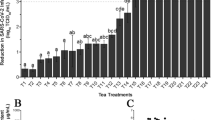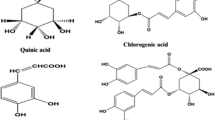Abstract
Hibiscus sabdariffa extract is known to have antioxidant, anti-diabetic, and antimicrobial properties. However, their effects against foodborne viruses are currently unknown. The objective of this study was to determine the antiviral effects of aqueous extracts of H. sabdariffa against human norovirus surrogates (feline calicivirus (FCV-F9) and murine norovirus (MNV-1)) and hepatitis A virus (HAV) at 37 °C over 24 h. Individual viruses (~5 log PFU/ml) were incubated with 40 or 100 mg/ml of aqueous hibiscus extract (HE; pH 3.6), protocatechuic acid (PCA; 3 or 6 mg/ml, pH 3.6), ferulic acid (FA; 0.5 or 1 mg/ml; pH 4.0), malic acid (10 mM; pH 3.0), or phosphate buffered saline (pH 7.2 as control) at 37 °C over 24 h. Each treatment was replicated thrice and plaque assayed in duplicate. FCV-F9 titers were reduced to undetectable levels after 15 min with both 40 and 100 mg/ml HE. MNV-1 was reduced by 1.77 ± 0.10 and 1.88 ± 0.12 log PFU/ml after 6 h with 40 and 100 mg/ml HE, respectively, and to undetectable levels after 24 h by both concentrations. HAV was reduced to undetectable levels by both HE concentrations after 24 h. PCA at 3 mg/ml reduced FCV-F9 titers to undetectable levels after 6 h, MNV-1 by 0.53 ± 0.01 log PFU/ml after 6 h, and caused no significant change in HAV titers. FA reduced FCV-F9 to undetectable levels after 3 h and MNV-1 and HAV after 24 h. Transmission electron microscopy showed no conclusive results. The findings suggest that H. sabdariffa extracts have potential to prevent foodborne viral transmission.






Similar content being viewed by others
References
Ali, B. H., Al Wabel, N., & Blunden, G. (2005). Phytochemical, pharmacological and toxicological aspects of Hibiscus sabdariffa L.: A review. Phytotherapy Research, 19(5), 369–375. doi:10.1002/ptr.1628.
Blanton, L. H., Adams, S. M., Beard, R. S., Wei, G., Bulens, S. N., Widdowson, M. A., et al. (2006). Molecular and epidemiologic trends of caliciviruses associated with outbreaks of acute gastroenteritis in the United States, 2000–2004. Journal of Infectious Diseases, 193(3), 413–421. doi:10.1086/499315.
Borges, A., Ferreira, C., Saavedra, M. J., & Simoes, M. (2013). Antibacterial activity and mode of action of ferulic and gallic acids against pathogenic bacteria. [Research Support, Non-U.S. Gov’t]. Microbial Drug Resistance, 19(4), 256–265. doi:10.1089/mdr.2012.0244.
Chao, C. Y., & Yin, M. C. (2009). Antibacterial effects of roselle calyx extracts and protocatechuic acid in ground beef and apple juice. Foodborne Pathogens and Disease, 6(2), 201–206. doi:10.1089/fpd.2008.0187.
Chaudhary, R. K., & Andonov, A. P. (1992). Effect of ribavirin on hepatitis A virus replication in vitro. Canadian Journal of Infectious Diseases, 2, 67–70.
Chomnawang, M. T., Surassmo, S., Nukoolkarn, V. S., & Gritsanapan, W. (2005). Antimicrobial effects of Thai medicinal plants against acne-inducing bacteria. [Research Support, Non-U.S. Gov’t]. Journal of Ethnopharmacology, 101(1–3), 330–333. doi:10.1016/j.jep.2005.04.038.
Cowan, M. M. (1999). Plant products as antimicrobial agents. [Review]. Clinical Microbiology Reviews, 12(4), 564–582.
Hall, A. J., Wikswo, M. E., Pringle, K., Gould, L. H., Parashar, U. D., Division of Viral Diseases, National Center for Immunization and Respiratory Diseases, CDC, et al. (2014). Vital signs: foodborne norovirus outbreaks—United States, 2009–2012. MMWR Morbidity and Mortality Weekly Report, 63(22), 491–495.
Higginbotham, K. L., Burris, K. P., Zivanovic, S., Davidson, P. M., & Stewart, C. N., Jr. (2014a). Aqueous extracts of Hibiscus sabdariffa calyces as an antimicrobial rinse on hot dogs against Listeria monocytogenes and methicillin-resistant Staphylococcus aureus. Food Control, 40, 274–277. doi:10.1016/j.foodcont.2013.12.011.
Higginbotham, K. L., Burris, K. P., Zivanovic, S., Davidson, P. M., & Stewart, C. N., Jr. (2014b). Antimicrobial activity of Hibiscus sabdariffa aqueous extracts against Escherichia coli O157:H7 and Staphylococcus aureus in a microbiological medium and milk of various fat concentrations. [Research Support, Non-U.S. Gov’t]. Journal of Food Protection, 77(2), 262–268. doi:10.4315/0362-028X.JFP-13-313.
Kakkar, S., & Bais, S. (2014). A review on protocatechuic acid and its pharmacological potential. [Review]. ISRN Pharmacology, 2014, 952943. doi:10.1155/2014/952943.
Katayama, S., Ohno, F., Yamauchi, Y., Kato, M., Makabe, H., & Nakamura, S. (2013). Enzymatic synthesis of novel phenol acid rutinosides using rutinase and their antiviral activity in vitro. Journal of Agriculture and Food Chemistry, 61(40), 9617–9622. doi:10.1021/jf4021703.
Lin, H. H., Huang, H. P., Huang, C. C., Chen, J. H., & Wang, C. J. (2005). Hibiscus polyphenol-rich extract induces apoptosis in human gastric carcinoma cells via p53 phosphorylation and p38 MAPK/FasL cascade pathway. [Research Support, Non-U.S. Gov’t]. Molecular Carcinogenesis, 43(2), 86–99. doi:10.1002/mc.20103.
Liu, K. S., Tsao, S. M., & Yin, M. C. (2005). In vitro antibacterial activity of roselle calyx and protocatechuic acid. Phytotherapy Research, 19(11), 942–945. doi:10.1002/ptr.1760.
McKay, D. L., Chen, C. Y., Saltzman, E., & Blumberg, J. B. (2010). Hibiscus sabdariffa L. tea (tisane) lowers blood pressure in prehypertensive and mildly hypertensive adults. [Randomized Controlled Trial Research Support, Non-U.S. Gov’t Research Support, U.S. Gov’t, Non-P.H.S.]. Journal of Nutrition, 140(2), 298–303. doi:10.3945/jn.109.115097.
Morton, J. (1987). Roselle. In Fruits of warm climates (pp. 281–286). Miami, FL: Creative Resource Systems, Inc.
Oh, E.-G., Kim, K.-L., Shin, S., Son, K.-T., Lee, H.-J., Kim, T., et al. (2013). Antiviral activity of green tea catechins against feline calicivirus as a surrogate for norovirus. Food Science and Biotechnology, 22(2), 593–598. doi:10.1007/s10068-013-0119-4.
Olaleye, M. (2007). Cytotoxicity and antibacterial activity of methanolic extract of Hibiscus sabdariffa. Journal of Medicinal Plants Research, 1, 9–13.
Povey, R. C. (1978a). In vitro antiviral efficacy of ribavirin against feline calicivirus, feline viral rhinotracheitis virus, and canine parainfluenza virus. American Journal of Veterinary Research, 39(1), 175–178.
Povey, R. C. (1978b). Effect of orally administered ribavirin on experimental feline calicivirus infection in cats. American Journal of Veterinary Research, 39(8), 1337–1341.
Ravishankar, S., Jaroni, D., Zhu, L., Olsen, C., McHugh, T., & Friedman, M. (2012). Inactivation of Listeria monocytogenes on ham and bologna using pectin-based apple, carrot, and hibiscus edible films containing carvacrol and cinnamaldehyde. [Research Support, Non-U.S. Gov’t Research Support, U.S. Gov’t, Non-P.H.S.]. Journal of Food Science, 77(7), M377–M382. doi:10.1111/j.1750-3841.2012.02751.x.
Saini, P., Gayen, P., Nayak, A., Kumar, D., Mukherjee, N., Pal, B. C., et al. (2012). Effect of ferulic acid from Hibiscus mutabilis on filarial parasite Setaria cervi: molecular and biochemical approaches. [Research Support, Non-U.S. Gov’t]. Parasitology International, 61(4), 520–531. doi:10.1016/j.parint.2012.04.002.
Scallan, E., Hoekstra, R. M., Angulo, F. J., Tauxe, R. V., Widdowson, M. A., Roy, S. L., et al. (2011). Foodborne illness acquired in the United States—Major pathogens. Emerging Infectious Diseases, 17(1), 7–15. doi:10.3201/eid1701.091101p1.
Su, X., & D’Souza, D. H. (2011). Grape seed extract for control of human enteric viruses. Applied and Environment Microbiology, 77(12), 3982–3987. doi:10.1128/AEM.00193-11.
Su, X., & D’Souza, D. H. (2013). Grape seed extract for foodborne virus reduction on produce. Food Microbiology, 34(1), 1–6. doi:10.1016/j.fm.2012.10.006.
Su, X., Howell, A. B., & D’Souza, D. H. (2010a). Antiviral effects of cranberry juice and cranberry proanthocyanidins on foodborne viral surrogates—A time dependence study in vitro. [Research Support, Non-U.S. Gov’t]. Food Microbiology, 27(8), 985–991. doi:10.1016/j.fm.2010.05.027.
Su, X., Howell, A. B., & D’Souza, D. H. (2010b). The effect of cranberry juice and cranberry proanthocyanidins on the infectivity of human enteric viral surrogates. Food Microbiology, 27(4), 535–540. doi:10.1016/j.fm.2010.01.001.
Sunday, O. A., Munir, A. B., Akeeb, O., Bolanle, A., & Badaru, S. O. (2010). Antiviral effect of Hibiscus sabdariffa and Celosia argentea on measles virus. African J Microbioloical Research, 4(4), 293–296.
Tsai, P.-J., McIntosh, J., Pearce, P., Camden, B., & Jordan, B. R. (2002). Anthocyanin and antioxidant capacity in Roselle (Hibiscus sabdariffa L.) extract. Food Research International, 35(4), 351–356. doi:10.1016/S0963-9969(01)00129-6.
Xu, J., Wang, J., Deng, F., Hu, Z., & Wang, H. (2008). Green tea extract and its major component epigallocatechin gallate inhibits hepatitis B virus in vitro. Antiviral Research, 78(3), 242–249. doi:10.1016/j.antiviral.2007.11.011.
Yang, Y. S., Wang, C. J., Huang, C. N., Chen, M. L., Chen, M. J., & Peng, C. H. (2013). Polyphenols of Hibiscus sabdariffa improved diabetic nephropathy via attenuating renal epithelial mesenchymal transition. [Research Support, Non-U.S. Gov’t]. Journal of Agriculture and Food Chemistry, 61(31), 7545–7551. doi:10.1021/jf4020735.
Yin, M. C., & Chao, C. Y. (2008). Anti-Campylobacter, anti-aerobic, and anti-oxidative effects of roselle calyx extract and protocatechuic acid in ground beef. International Journal of Food Microbiology, 127(1–2), 73–77. doi:10.1016/j.ijfoodmicro.2008.06.002.
Acknowledgments
Funding for this research was provided partly by the Professional Development Award to D. D’Souza from the UT-Graduate School and partly by the University of Tennessee-Institute of Agriculture (TEN #00391), which is gratefully acknowledged. The authors also acknowledge Dr. Dunlap at UT-Advanced Microscopy Center for his assistance with the TEM observation and Dr. Malcond Valladares for his assistance with the Hibiscus calyx extract preparations.
Author information
Authors and Affiliations
Corresponding author
Rights and permissions
About this article
Cite this article
Joshi, S.S., Dice, L. & D’Souza, D.H. Aqueous Extracts of Hibiscus sabdariffa Calyces Decrease Hepatitis A Virus and Human Norovirus Surrogate Titers. Food Environ Virol 7, 366–373 (2015). https://doi.org/10.1007/s12560-015-9209-1
Received:
Accepted:
Published:
Issue Date:
DOI: https://doi.org/10.1007/s12560-015-9209-1




